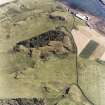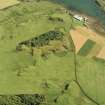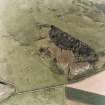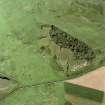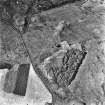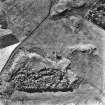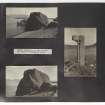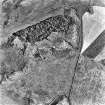Canna, St Columba's Graveyard, Sculptured Cross
Cross (Early Medieval)
Site Name Canna, St Columba's Graveyard, Sculptured Cross
Classification Cross (Early Medieval)
Alternative Name(s) Keill, St Columba's Chapel, Canna Cross
Canmore ID 10705
Site Number NG20NE 2
NGR NG 2695 0553
Datum OSGB36 - NGR
Permalink http://canmore.org.uk/site/10705
- Council Highland
- Parish Small Isles
- Former Region Highland
- Former District Lochaber
- Former County Inverness-shire
A’ Chill 12 (St Columba), Canna, Skye & Lochalsh, cross and cross-base
Measurements: cross H 2.11m above base, W at base of shaft 0.54m, D 0.26m; base 0.98m by 0.81m, socket 0.55m by 0.28m.
Stone type: yellow sandstone
Place of discovery: NG 2695 0553
Present location: in a field at A’ Chill.
Evidence for discovery: first recorded in the mid nineteenth century, when traces were still visible close by of the early medieval church and graveyard. The cross is oriented with its broad faces east and west. Two fragments of the upper sections of the ring were found in the neighbouring field.
Present condition: very weathered, and the upper and south arms are missing, as is most of the south face of the shaft (face D). The original span of the cross-head would have been about 1.35m.
Description
This was once an imposing and elaborately decorated ringed cross, set in a solid base which is enclosed by a kerb of low upright slabs. The ornament includes figural, zoomorphic and interlace designs, carved in relief, and it appears that all faces of the cross were ornamented. The shaft is carved in two levels of relief, a central higher panel and a lower flange on either side, giving an impression of the treatment of a cross-slab to this free-standing cross. The central panel on face A is in higher relief than that on face C.
The east face (A) shows vestiges of entwined animal ornament on the surviving side-arm and central roundel of the cross-head, and the motifs on the central panel of the shaft are presented in one continuous field. At the top, immediately beneath the central roundel is a two-legged animal above a supine quadruped. Below them is a rider on a horse trotting to the left, with a possible signifier motif above the horse’s rump. Below the horse are two much larger figures: on the left a seated woman and child and on the right a kneeling bearded man with very long hair, offering objects towards the child. At the foot of the shaft are two supine animals, a deer above a dog-like animal. The flange on the right-hand side is carved mostly with interlace patterns, but at the top the ring-section bears an elongated robed figure apparently supporting the right-hand arm.
The north narrow face (B) bears the rounded figure supporting the arm at the top, with two smaller figures below, one above the other and both frontal. There is interlace ornament on the end of the surviving arm.
On the west face (C), the top of the shaft is carved to represent the lower arm of an equal-armed cross, and it contains diagonal key pattern. The side-arm appears also to have been filled with interlace, as is the central roundel where there are four scroll-like designs. All the elements of this face are framed by narrow roll mouldings. The lower part of the shaft is divided into four panels, the top three of which contain entwined elongated animals and interlace. The lowest panel is carved with confronted S-dragons guarding a central human figure. The flange bears interlace ornament.
Date range: eighth or ninth century.
Primary references: Stuart 1867, pls 50-1; ECMS pt 3, 107-9; Fisher 2001, 96-7.
Compiled by A Ritchie 2016
NG20NE 2 2695 0553.
(NG 2695 0553) Stone Cross (NR) (Sculptured)
OS 6" map, Inverness-shire, 2nd ed., (1903)
A free-standing cross of yellow sandstone situated in the old burial ground of St Columba's Church, Canna. It is c. 6 1/2' in height with one limb of the cross only remaining.
J Stuart 1867; RCAHMS 1928, visited 1925.
This cross (as described and illustrated by RCAHMS) still stands within the site of the old burial ground.
Visited by OS (A A) 12 January 1972.
Cross, A' Chill. Worn shaft and one arm of a cross, perhaps of the 8th or 9th centuries, the W face carved with intertwined figures and a panel of key pattern, the E more robustly with figures including animals, a horseman and perhaps the Holy Family.
J Gifford 1992.
(Location amended to NG 2697 0553). There is no change to this record.
Visited by RCAHMS (ARG), 13 August 1996
Field Visit (3 July 1925)
Sculptured Cross and Slabs, A'Chill.
The site of St Columba's Chapel [Canmore ID 10694] is marked by the finely-sculptured free standing sandstone cross [10705] of unusual type which stands by the graveyard in a valley rather less than ¼ mile north of Canna post office. Mutilated by the loss of the top and one sidearm, the cross has a present height of 6 feet 5 inches, and when entire had a width of 4 feet 4 inches over the arms. The shaft has a total thickness of 8 inches and a total width of 2 feet, but the outer parts of both obverse and reverse are set back about 2 inches and terminate at the arms in bracket-like projections. The cross head has a central circular panel on either face, to meet which the remaining arm tapers and is incurved. Each face and side is sculptured. On the front, which faces eastward, the sculptures are mainly in high relief. On the head the circular panel, 1 foot 3 inches in diameter, is very weatherworn and bears what appears to be a serpentine pattern; the arm is also sculptured, but the device is illegible. On the outer portion of the shaft the uppermost sculpture represents an animal with an elephant's head and trunk, forelegs of a horse and rudimentary hind legs; beneath is an animal turning back and biting its body, the tail being tufted like a lion's; below this is a figure on horseback carved with great spirit; the rider wears a hood and a loose coat with a tail, his legs are bare or tightly swathed. The horse has a bit and reins, and there is an object roughly bag-shaped above the rump. Beneath this is a group comprising a woman wearing the hair curled, clad in a frock of ankle length, with a child in her left arm, and another figure represented in profile with long hair and beard, holding a bag or vessel. The lowest sculpture represents two amorphous creatures resembling fish. On the receding portion of the shaft there is, below the remaining portion of the arm, what seems to be an angel worked into the bracket-like projection, and lower down a mole-like animal and a piece of interlaced work. The outer side of this part of the shaft is also sculptured with panels containing heads and busts, while on the outer surface of the arm is a boldly-cut knot. (Figs. 299, 300.)
The reverse side of the shaft is greatly worn and bears in low relief a series of interlaced panels containing, apparently, animals intertwined in places. The topmost panel is cut in a diagonal key pattern. The cross is firmly set in a backing of stones, and at its base lies a fragment of a saddle quern. (Cf. Early Christian Monuments, pp. 107-9.)
CARVED SLAB. Within the churchyard, close to the west boundary wall, is a slab of micaceous schist, covering a modern grave, sculptured with a heterogeneous assemblage of objects (Fig. 301.) It is 5 feet 8½ inches in length, 3½ inches thick, and has an average breadth of 1 foot. Filling the upper dexter corner is a small patera, and the remainder of the top is occupied by a figure holding in the left hand a large sword, the hilt of which he is hammering, the hammer being held with the right hand; beside the hammer, but not connected with it, is an object resembling a short gun. Below the patera is a long-bladed tool with a spade handle, rather like a peat spade, and below this what may be a saw or perhaps a harrow. Below the figure is an object unidentified and beside this an arrowhead of flint and not metal type. Terminating the upper group of sculptures is a bird, probably an eagle, carved back-down athwart the stone; separating the two groups is a plain panel uncarved, possibly intended for an inscription. The lower group starts with a representation of two conventional trees, but to read these in proper position the stone must be reversed. There is a rectangular object on the dexter side resembling a mason's square. Thereafter follows an interlaced pattern based on a cross saltire, and the group is terminated with a snake (?) arranged like the letter M. Apparently two people are commemorated by this slab, the symbols beginning at either end.
RCAHMS 1928, visited 3 July 1925.
OS map: Islands of Canna and Sanday (Inverness-shire)lix.
Photographic Survey (August 1965)
Photographic survey by the Scottish National Buildings Record in August 1965.
Field Visit (13 August 1996)
(Location amended to NG 2697 0553). There is no change to this record.
Visited by RCAHMS (ARG), 13 August 1996
Reference (2001)
Free-standing cross of yellow sandstone, lacking the S and top arms and damaged at the S edge. It stands in what is probably its original sandstone base-slab and measures 2.11m in visible surviving height by 0.54m in width at the base and 0.26m in maximum thickness. It is of unusual form, having a central flange about 100mm thick on each edge, although that to the S is broken off except at the base. The N flange increases in projection from 80mm at the base to 120mm below the cross-head, which had pierced semicircular armpits about 110mm in diameter. The upper part of the flange curves to form a concave bracket supporting the N side-arm, whereas two fragments found in the neighbouring field appear to have been the upper quadrants of a ring of more conventional type. The arm, which is 0.34m high, projects 0.4m beyond the armpit, and the original span of the cross-head was about 1.35m.
The cross has been richly decorated, but as well as being incomplete it is much weathered. The E face is carved in relief, up to 50mm in depth, with a series of figure and animal scenes without any division or enclosing moulding. At the foot of the shaft, above a base moulding, there is a recumbent dog-like creature with a long neck curving down to bite its tail, and above it a stag with branching antlers, also recumbent. This is followed at the left by a tall figure, apparently female, wearing an ankle-length garment with what appears to be a penannular brooch with horizontal pin at the breast. She is shown in a seated posture, although no chair is visible, with the lower body in profile but the head facing the viewer. She holds a small infant towards a kneeling figure at the right who carries a vessel with a handle and perhaps a spout. This appears to be the Virgin and Child with one of the Magi, and the same theme may continue in the next register which shows a rider moving towards the left. Although much worn, the horse is well proportioned, with two legs raised high and reins and a possible cruciform harness-mount shown in detail, and the scene is closely related to similar figures on Pictish slabs. The rider holds a staff or crosier, whose shaft appears in front of his visible leg. Above the horse's rump there is another motif, perhaps a seated animal but too worn for certain identification. At the top of the shaft there are two animals which appear to be associated. The lower one, with long curving tail and body, has its forequarters twisted round to look at the two-legged creature above. This again has its neck bent to look at the other, and appears to have a double beak, and it has been suggested that it represents the basilisk, which in medieval bestiaries was described as being defeated by its enemy the weasel with a sprig of rue (1). The E face of the N flange of the shaft shows interlace (RA 634) in the lower part, followed by interlocked spirals above and below an oval boss in the form of a crouching animal. An elongated atlas figure with bent knees, ribbed skirt, curving body and one arm outstretched above the head is carved in full relief to form the bracket supporting the surviving arm of the cross. The arm itself bears traces of an animal, and the centre of the cross-head has a damaged motif, perhaps a man between beasts or serpents, within a 0.38m circular moulding. The two ring-fragments, which probably belonged to the upper quadrants of this cross, are fluted on one face (2) and bear interlace on the other.
The W face is carved in low relief within an edge-moulding, but there is no moulding to separate the carved area from a low plain panel at the foot, which may have carried an inscription, or between the four panels of animal-ornament in the shaft. The lowest of these shows two upright sea-creatures whose gaping jaws threaten the head of a much-weathered human figure standing in the space formed by their plump curving bodies. The outer spandrels are filled by interlace, as are the spaces surrounding the serpentine creature in the next panel (3). The third panel appears to show two intertwined beasts, each with head curving down to bite the other's body. Above this there are two creatures whose curving bodies are looped together on the vertical axis and face outwards, surrounded by interlace (4). The upper part of the shaft is filled with a diagonal fret (5), and the circular centrepiece comprises four roundels of interlace surrounding a central lozenge and having further interlace in the spandrels. The N arm appears to have shown an over-all interlace pattern, weathered beyond recognition. The W face of the N flange of the shaft is covered with interlace up to the atlas figure, which preserves no detail on this face. The N face of the flange shows below the atlas figure two other human figures, set frontally but the lower one having flexed knees and legs turned to the left whereas the other is delicately raised on its toes. Both have large heads and their hands are crossed at waist-level, apparently carrying oblong objects which may be book-satchels although they might represent loincloths or aprons. The N end of the N side-arm bears an interlaced knot.
The two curved ring-fragments, which are now at Canna House, are of sandstone closely resembling that of the cross. The larger is 175mm long by 85mm high and the other 135mm by 75mm, and both are 85mm thick. Both project at one end of the inner curve, evidently where they were attached to the arms of the cross. On one face there are three concentric grooves forming a quadruple moulding, and the other bears much-weathered interlace within angular bead-mouldings.
The cross-base is a rectangular slab of sandstone, 0.98m by 0.81m and containing a socket 0.55m by 0.23m, within a raised kerb of sandstone slabs set on edge.
(1) I G Scott 1998, 2-3, quoting a 14th-century misericord in Worcester Cathedral. For the basilisk, see V-H Debidour 1961, 220-4.
(2) Cf. the Aberlemno churchyard stone (Allen and Anderson 1903, 3, fig.227A), and a small slab from the area of Abernethy, Perthshire (D Henry 1997, 56-7).
(3) Stuart's drawing (Stuart 1867, pl.51) and Allen's description (Allen and Anderson 1903, 3, 108) conflate these two panels to form a single pair of animals.
(4) For an ingenious but unconvincing interpretation of these as sweet-voiced panthers, and of the interlace as musical notation, see J Cargill, Notes on the Old Cross at Canna (Chicago), summarised in J Travis 1968, 66-78.
(5) This appears to be a variant of RA nos.965-71, with single straight-line spirals, rather than RA 958 as suggested by Allen himself (loc.cit.).
Stuart 1867, pls.50-1; T S Muir 1885, pl.2 opp. p.32; E Beveridge 1922, 2, pls.298-300; Allen and Anderson 1903, 3, 107-9; RCAHMS 1928, No.678 and figs.299, 300, 304; J L Campbell 1994, pls.16-17 and colour pl.6; D Kelly 1991, 113-16; D Kelly 1995, in Bourke, From the Isles, 199-200; D MacLean 1997, 180; R Trench-Jellicoe 1999, 597-647.
I Fisher 2001.
Watching Brief (2002)
NG 2695 0553 The replacement of the post-and-rail fence around the Early Christian sculptured cross (NG20NE 2) required a watching brief to comply with Scheduled Monument Consent. The fence posts were driven into the same holes as those that had been created for the removed fence. No features of archaeological interest were recorded during this work.
Archive to be deposited in the NMRS.
Sponsor: NTS.
J Harden 2002.























































































